MXA RACE TEST: THE REAL TEST OF THE 2020 KTM 250SXF
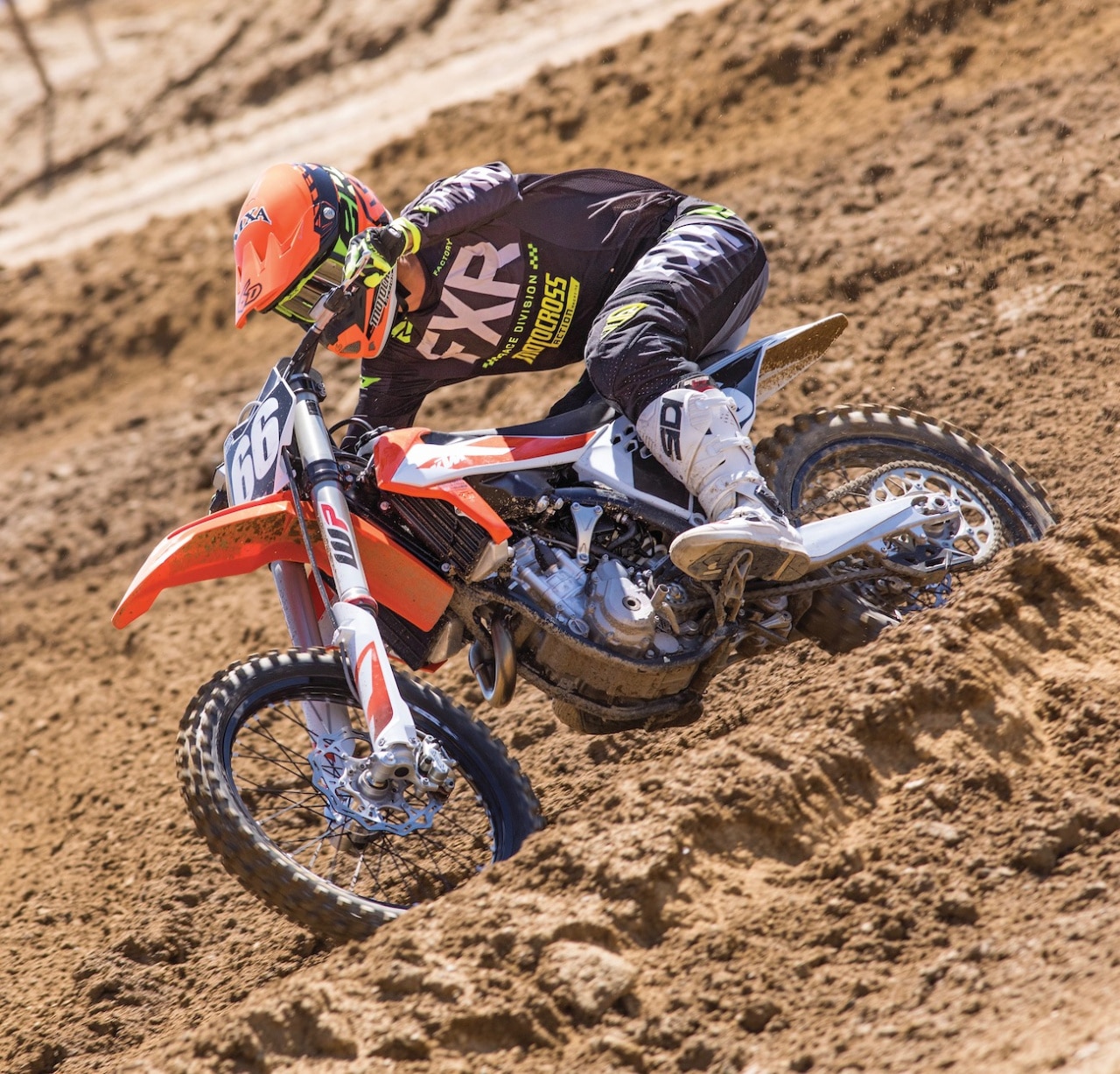
MXA RACE TEST: THE REAL TEST OF THE 2020 KTM 250SXF FOUR-STROKE MOTOCROSS BIKE
Q: FIRST & FOREMOST, IS THE 2020 KTM 250SXF BETTER THAN THE 2019 KTM 250SXF?

A: Yes. Somehow the KTM 250SXF has a magically improved powerband. What do we mean by “magically”? KTM Austria told us the engine and ECU are identical equipment from the 2019 model; however, on the track, the bike is definitely improved. So, what gives? We have a clue.
Q: WHAT IS UPDATED ON THE 2020 KTM 250SXF?
A: There are minor updates to the 250SXF for 2020; however, these changes made a significant difference. This is what we know.
(1) Fork caps. The fork caps are updated to bleed air more easily. You need a #20 Torx to bleed the air out of the forks. There used to be Phillips head screws on the air-bleed holes. Let’s go back to them, because everybody in America own a Phillips screwdriver—a #20 Torx not so much. On the compression side, a new two-prong compression adjuster is used instead of the three-prong adjuster. We like two prongs less than we liked three.
(2) Forks. The 48mm WP AER air forks are now called XACT forks for 2020. The XACT forks have been updated. The mid-valve piston now has a knife edge to help with initial compression shim breakaway. A 28.1mm bleed shim was added in front of the 30.1mm face shims to allow oil to flow through easier. These same changes were made on the 2020 Husqvarna FC250; however, the settings and oil height (220cc on the KTM and 200cc on the Husky) are among several differences between the two bikes. For the first time since Stefan Pierer bought Husky from BMW and started platform-sharing with KTM, the Husqvarna suspension differs from the KTM suspension.
(3) Shock. The WP XACT shock offers updated settings with a new compression adjuster.
(4) Airbox. In 2019, KTM’s engineers made the airbox smaller and more restrictive. We don’t know what they were thinking. It suffocated the engine’s throttle response, which softened the power output, especially from low to mid. For 2020, KTM kept the same airbox and cover but included an optional perforated airbox cover to flow significantly more air. Run the vented airbox cover.
(5) BNG. The graphics have been altered slightly, but the wavy design scheme is getting very long in the tooth.
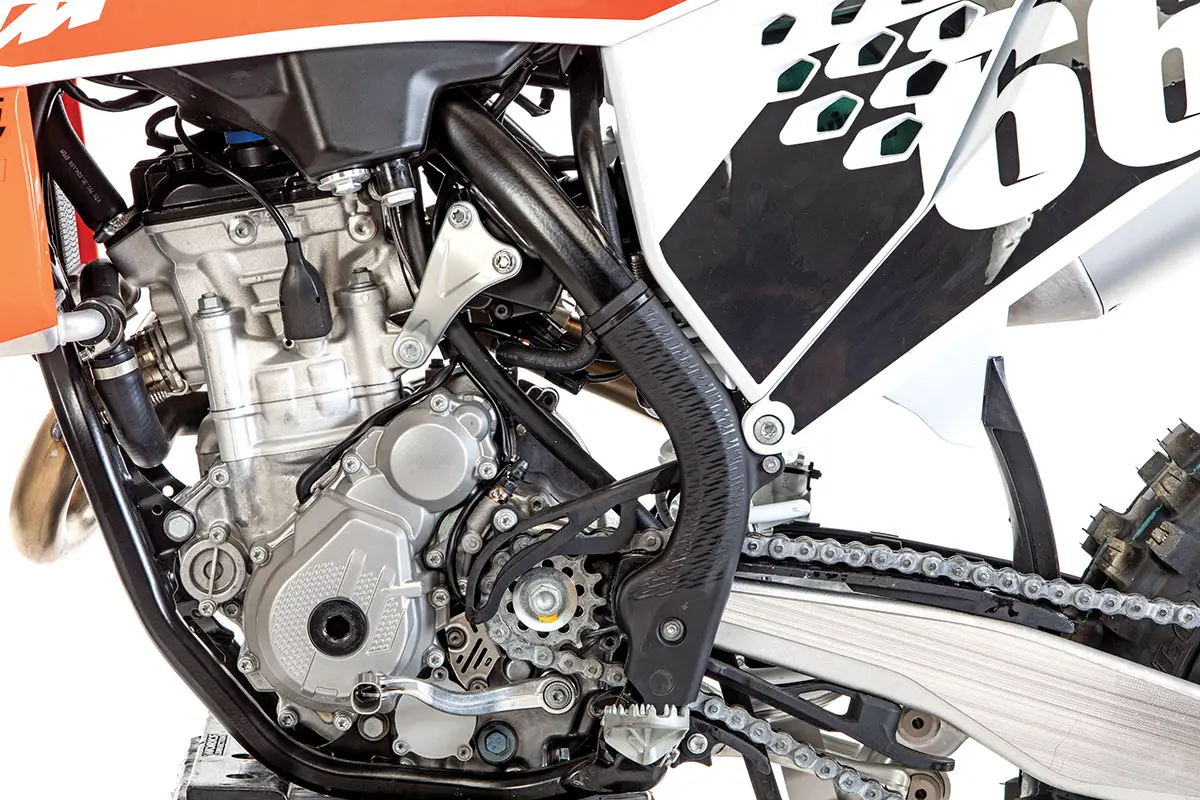
Q: WHY DOES THE POWERBAND FEEL IMPROVED IF THE ENGINE’S MECHANICAL PARTS ARE THE SAME AS LAST YEAR’S?
A: Because they are not the same as last year’s. Huh? Even though KTM Austria told us the powerplant of the 2020 KTM 250SXF was identical to the 2019 model, it’s not. On the dyno, and on the more important dirt dyno, something doesn’t add up. If the two bikes were identical, the dyno charts would be the same, right? Well, they aren’t. To everyone’s surprise, the 2019 engine performed slightly better than the 2020 250SXF engine—most notably from 8500 rpm to 11,000 rpm (with the non-vented airbox cover). When we used the perforated airbox cover, the dyno curve of the 2019 (with no vents) and 2020 250SXFs (with vents) are identical. 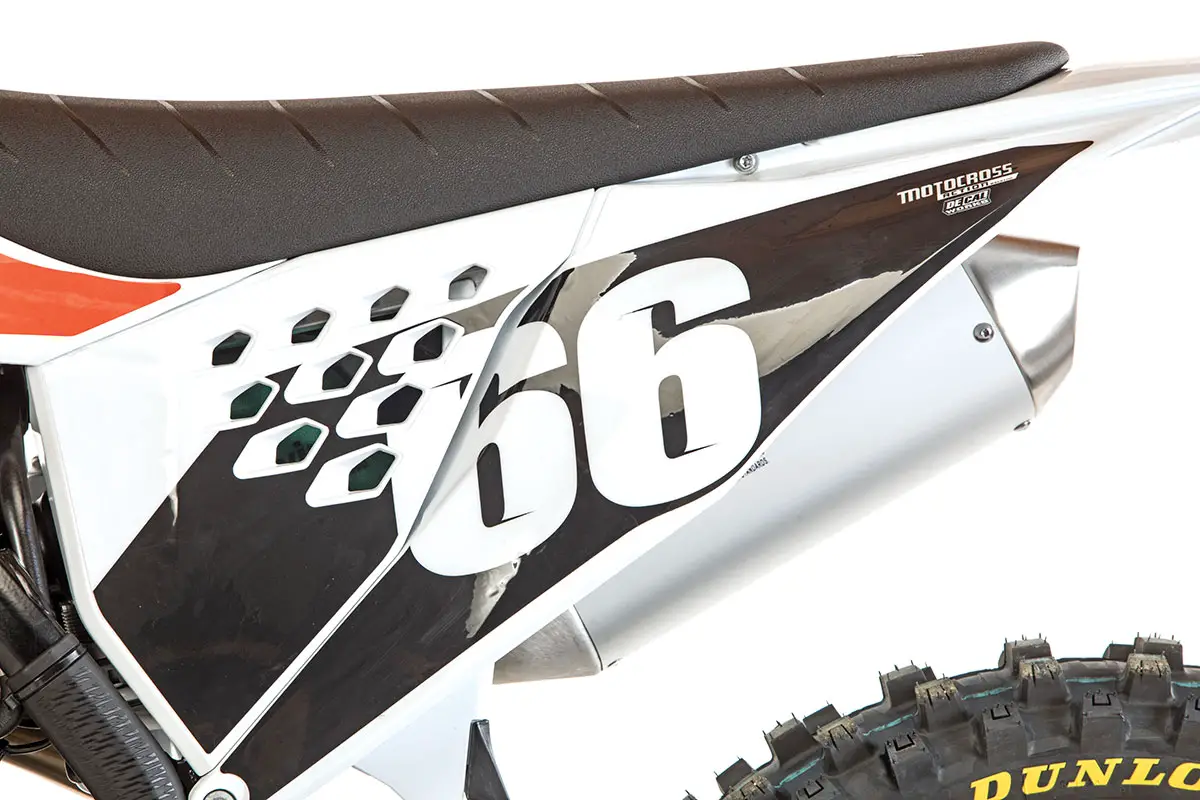
Holy moly! Yet, on the track, the 2020 250SXF pulls the super-tall 14/51 gearing that the 2019 struggled with on hills, in sand and in heavy loam. In 2019, every MXA test rider went with lower gearing due to the soft bottom-end grunt. In our 2019 KTM 250SXF test, we said this: “With the first crack of the throttle, you feel like something is missing. It feels like the engine has a restrictor on it.” The 2020 250SXF doesn’t feel that way. It pulls hard and strong through the powerband without re-gearing. So, what gives? Our best bet is that KTM used a different map, even if they claim they didn’t. There is no way of telling, as KTM Austria used the same code when we plugged it in as last year. In back-to-back tests, running the 2020 black box and the 2019 black box on the 2020 engine, the 2020 black box was stronger from bottom and up.
Q: DID THE OPTIONAL VENTILATED AIRBOX COVER MAKE A SIGNIFICANT DIFFERENCE?
A: On the dyno, there wasn’t much difference. It did fill in the flat spot from 8500 to 11,000 rpm, but only added a measly 0.05 horsepower at peak; however, in the dirt, the ventilated airbox cover livened up the powerband, sped up the throttle response and from the crack of the throttle, the 2020 KTM 250SXF is more responsive, offers more grunt from low-to-mid, fills in the dip in the high midrange, and revs through the extremely broad powerband faster. The vents are a win/win across the board.
Q: WERE THE UPDATED WP COMPONENTS A STEP IN THE RIGHT DIRECTION?
A: Over the years, KTM has been all over the map with its suspension settings. They have been so soft that they bottom if you hit a pebble and so stiff you could race an Anaheim Supercross on them. Since the inception of WP’s 48mm AER forks, (now called XACT forks), KTM’s suspension has been on the stiff side, which wasn’t a complete disaster, because test riders could dramatically drop the air pressure and oil level to get the forks to work for their weight and skill level.
The bad part about this was most weekend warriors didn’t know how to fix the problem, as their manuals told them to stay within certain parameters. WP recommended 156 psi, but the vast majority of local racers would run as little as 135 psi. The book’s recommendation was too stiff.
What made matters worse was that in 2019, KTM went with a more rigid chassis, and our Band-Aid fixes no longer worked. We got the numbers in the ballpark, but the stock valving was too stiff for the firm chassis. Only fast riders could put up with the harsh feel.
For 2020, KTM reworked the suspension on the entire SX line in an effort to soften the harsh feeling. Thus far, KTM has accomplished that goal on the 2020 450SXF and now the 250SXF. Our testers felt at home with the standard-pressure 149 psi (10.3 bar) for the first time in years. We didn’t have to go way out on the compression like we normally do. The stock settings were in the ballpark for the majority of our testers. As for the shock, it balanced well with the WP forks.
With the WP components being softer and plusher throughout their stroke, it mellowed the feel of the harsh chassis. All our testers liked this more forgiving feel in comparison to the rigid feel of 2019. Equally interesting, the 2020 Husqvarna suspension settings are much plusher than KTM’s setup—and most test riders, save for the Pros, like Husky’s setup better than KTM’s.
Q: DID WE CHANGE THE GEARING FOR 2020?
A: Since the engine has more grunt in the midrange of the powerband, the tall gearing worked well for our faster testers. Last year we went from the stock 14/51 gearing to 14/53 gearing (or a 13/50 combination). For 2020, our Novice and Vet test riders preferred to run a 14/52 combination because it shortened the long gaps between gears to make it more responsive. We prefer to stick with the 14-tooth countershaft sprocket for chain-line reason, not gearing.

Q: WHICH IS BETTER, MAP 1 OR MAP 2?
A: The standard map is Map 1 and the aggressive map is Map 2. Last year most of our testers liked Map 1 better than Map 2. This year, our testers favored the aggressive Map 2. Even Vets found that they could fine-tune Maps 1 and 2 by mating them with Traction Control (TC). This widened the available number of maps twofold and made traction control more part-time than full-time. On slippery surfaces, the chosen map is always Map 1 with TC engaged.
Q: WHAT DID WE HATE?
A: The hate list:
(1) Sprocket. Watch the sprocket bolts. They come loose.
(2) Spokes. The spokes still come loose. The one by the rim lock comes loose first.
(3) Bleed screws. Please change the forks’ bleed screws from Torx back to Phillips screws.
(4) Preload ring. The plastic pre-load ring can’t be the only way that WP engineers can think of to adjust a shock spring. There has to be a better option.
(5) Compression clicker. Two prongs aren’t better than three. What’s next? One prong? Just make the prongs longer and everyone will quit whining—including us.
(6) Frame stiffness. Making the frame stiffer in 2019 was great for ultra-fast riders who pushed the chassis hard; however, Vets and Novices think it’s too stiff.
(7) Lock-on grips. Although we like the ease of use of the ODI lock-on grips, glue-on grips have twice the rubber thickness for a more comfortable feel.
(8) Frame color. Let’s make the production bikes orange and the Grand Prix bikes black. That would make thousands of KTM buyers happy (and only Cairoli and Herlings sad).
Q: WHAT DID WE LIKE?
A: The like list:
(1) Weight. The 2020 KTM 250SXF is the lightest 250 four-stroke in its class, weighing 218 pounds (as much a 10 pounds lighter than some of its 250cc competition).
(2) Brakes. The KTM’s Brembo brakes are ahead of their competition.
(3) Air filter. This no-tools-built airbox makes changing an air filter foolproof.
(4) Hydraulic clutch. Having a self-adjusting bulletproof clutch means one less thing you have to think about.
(5) Skid plate. Mounting tabs for a skid plate are already welded under the frame.
(6) Power. This engine is famous for its high-rpm rev-ability, but it is very competitive off the bottom and into the midrange.
(7) Ergonomics. You feel comfortable the minute you swing a leg over the bike.
(8) Suspension. The updated suspension offers a much plusher ride than last year.
(9) Vented airbox. The optional ventilated airbox cover is free power.
(10) Traction control, launch control, two maps. The KTM 250SXF has push-button, on-demand traction control; maps; and launch control. Plus, the two maps can be combined with Traction Control to give racers four maps.

Q: WHAT DO WE REALLY THINK?
A: This is the lightest and fastest bike in its class. It offers an engine that makes 42-plus horsepower at 14,000 rpm. In a year where Honda and Kawasaki have chased after KTM’s signature high-rpm powerband, the KTM 250SXF is still the best—because it didn’t give up low-to-mid to get top. On the KTM 250SXF you don’t have to consistently shift like with many other 250 four-strokes. The ability to skip a shift and just let the engine rev makes the bike much easier to ride fast. Best of all, the way to get the most out of the KTM 250SXF is to resist shifting. If you want to unleash the 250SXF’s full potential, you rev it until your ears bleed. If you don’t rev it to the moon, the engine feels average. To top it all off, the 250SXF has great brakes, electric starting, a hydraulic clutch, creative air filter, WP suspension components and mind-control handling. This is the 250 four-stroke to own if you want to win races.
MXA’S 2020 KTM 250SXF SETUP SPECS
This is how we set up our 2020 KTM 250SXF for racing. We offer it as a guide to help you find your own sweet spot.
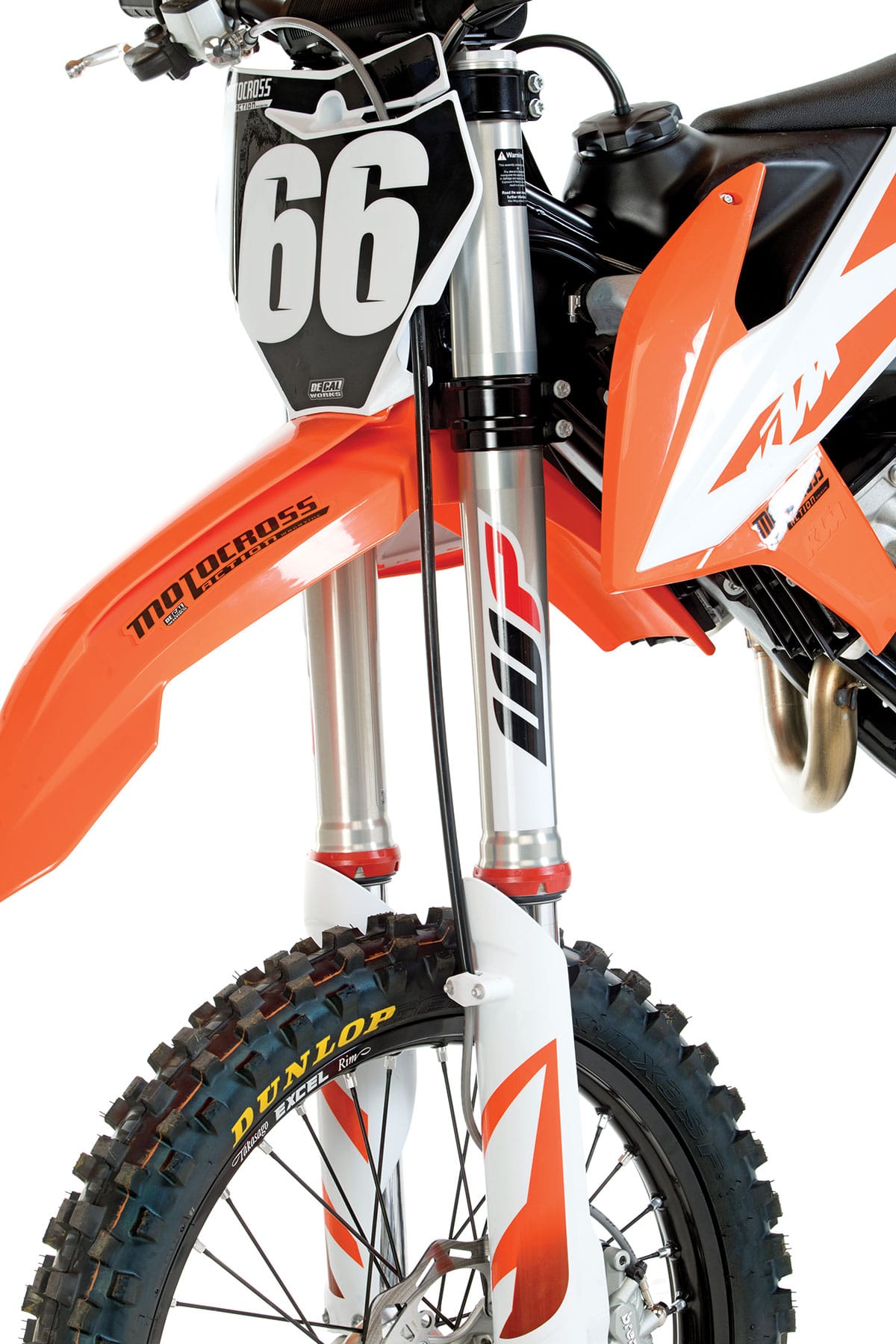
48MM XACT FORK SETTINGS
The stock KTM air fork setting is 149 psi. KTM went much softer on the valving and up on the air pressure, which improved the overall feel. This pressure worked well for many of our testers. If you are a lower-level rider, you can drop it down in 2-psi increments to find your sweet spot. Remember, you don’t need to drop the psi way down like last year. Stock psi is in the ballpark. For hardcore racing, we recommend this fork setup for an average rider on the 2020 KTM 250SXF (stock specs are in parentheses):
Air pressure: 149 psi
Compression: 15 clicks out
Rebound: 15 clicks out
Fork-leg height: Third line
Notes: Some testers slid the forks up in the clamps to the thrid or fourth line to put more weight on the front wheel. If you are having trouble getting far enough through the stroke or want to improve cornering characteristics, this will help. But, it will make the chassis trun quicker—which could be good or bad deprneding on your track.
WP SHOCK SETTINGS
Overall, this is a good shock. Although we do make clicker adjustments, we rarely stray very far from the stock 15 clicks out on compression. It can be dialed in with only a few clicker changes. As a rule of thumb, most MXA test riders leave the low-speed compression on the stock setting and focus on the high-speed dial to make the changes. For hard-core racing, we recommend this shock setup for the 2020 KTM 250SXF (stock specs are in parentheses):
Spring rate: 42 N/m
Race sag: 105 mm
Hi-compression: 2 turns out
Lo-compression: 15 clicks out
Rebound: 15 clicks out
Notes: Some testers like the sag at 107 mm, with the addition of the forks dropped to the fourth line. This brings the entire bike down.


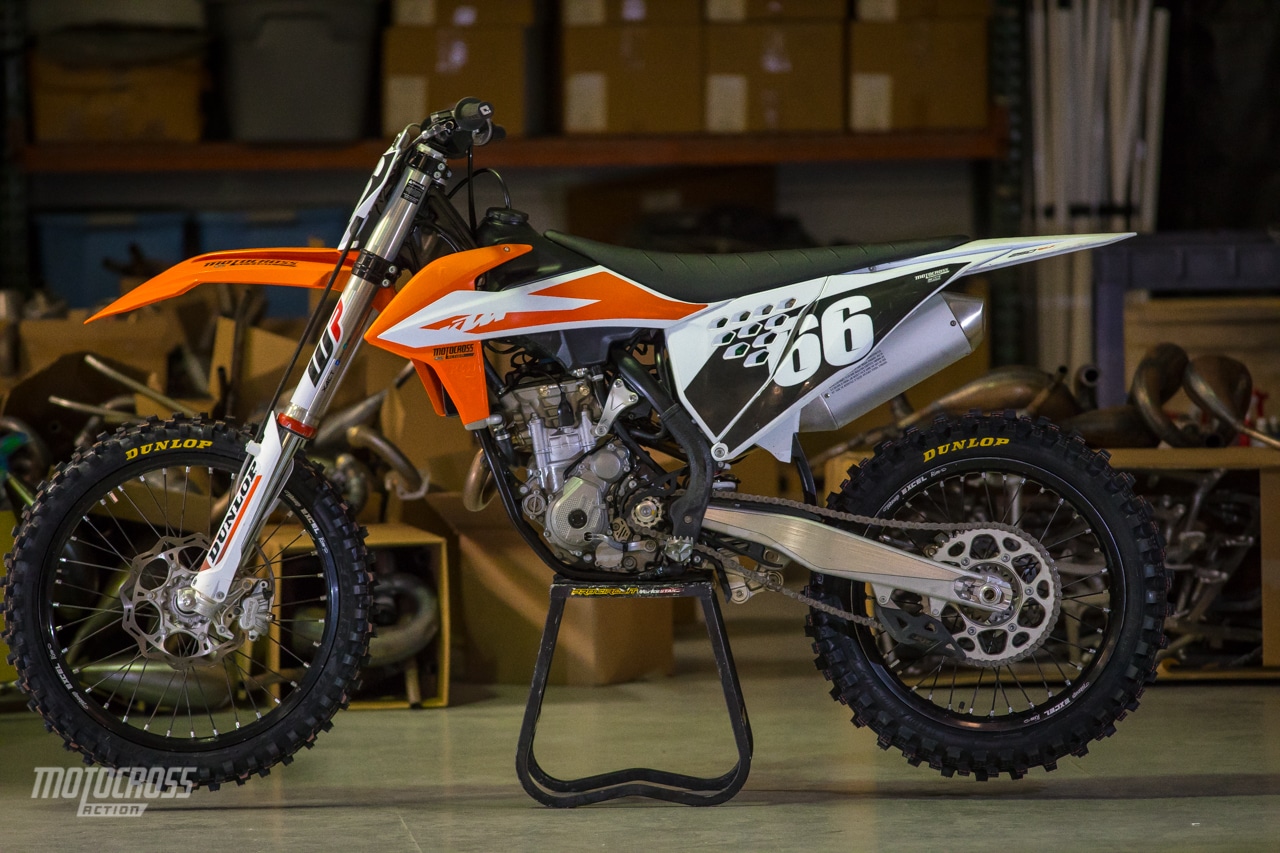
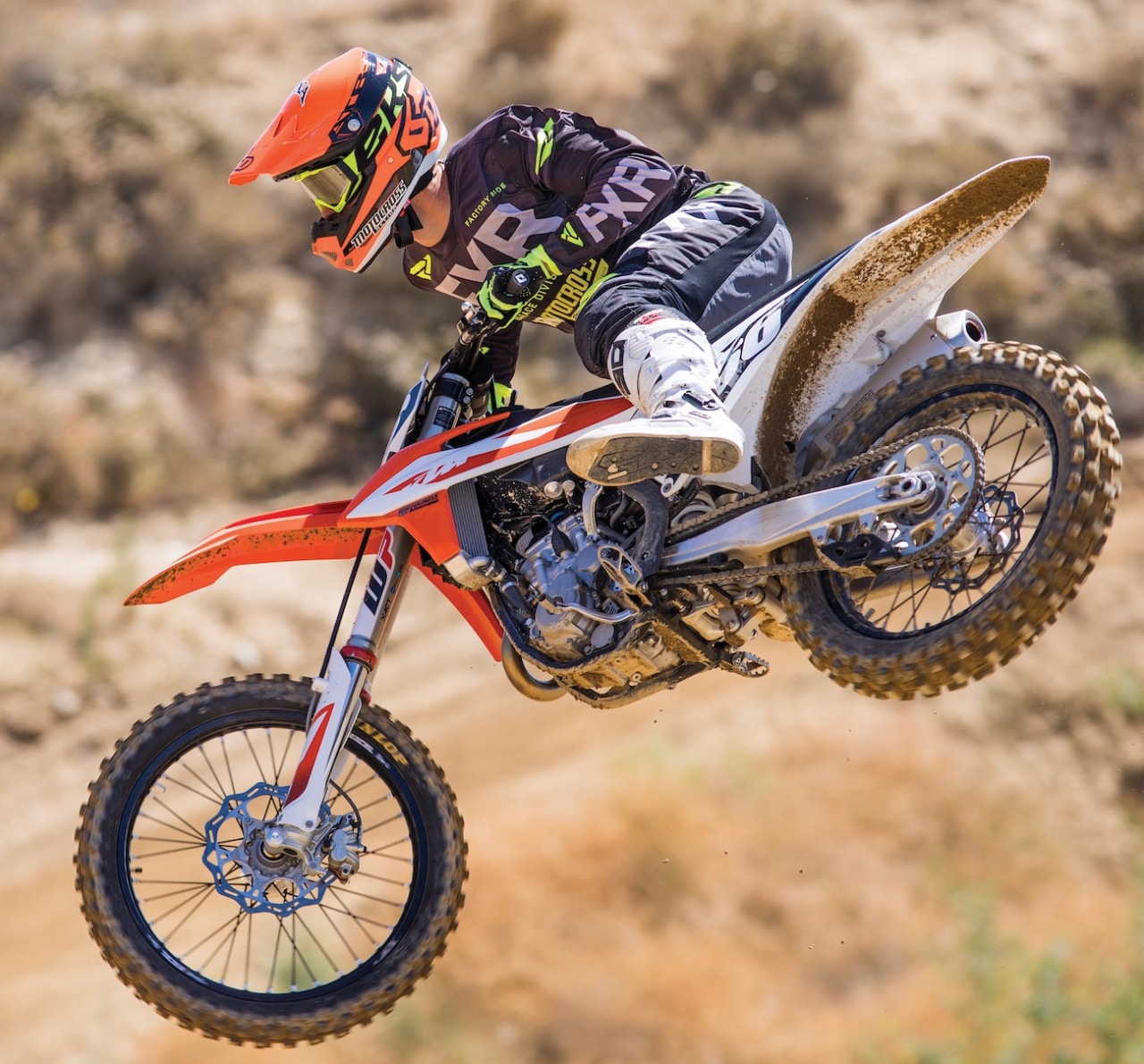








Comments are closed.